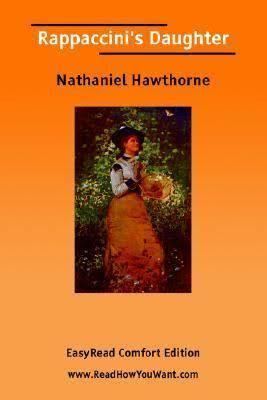Originally published 1844 | Publication date 1844 | |
 | ||
Similar Nathaniel Hawthorne books, Other books | ||
Rappaccini s daughter
"Rappaccini's Daughter" is a short story by Nathaniel Hawthorne first published in the December 1844 issue of The United States Magazine and Democratic Review, and later in the 1846 collection Mosses from an Old Manse. It is about Giacomo Rappaccini, a medical researcher in medieval Padua who grows a garden of poisonous plants. He brings up his daughter to tend the plants, and she becomes resistant to the poisons, but in the process she herself becomes poisonous to others. The traditional story of a poisonous maiden has been traced back to India, and Hawthorne's version has been adopted in contemporary works.
Contents
- Rappaccini s daughter
- Rappaccini s daughter full audiobook
- Plot summary
- Style
- Major themes
- Operas
- Plays
- Poetry
- Radio
- Television
- Film
- In popular culture
- References
Rappaccini s daughter full audiobook
Plot summary
The story is set in Padua, Italy, in a distant and unspecified past. From his quarters, Giovanni Guasconti, a young student of letters, at the University of Padua, looks at Beatrice, the beautiful daughter of Dr. Giacomo Rappaccini, a scientist who works in isolation. Beatrice is confined to the lush and locked gardens, which are filled with poisonous plants grown by her father. Giovanni notices Beatrice's strangely intimate relationship with the plants as well as the withering of fresh flowers and the death of an insect when exposed to her skin or breath. Having fallen in love, Giovanni enters the garden and meets with Beatrice a number of times, while ignoring his mentor, Professor Pietro Baglioni, who warns him that Rappaccini is devious and that he and his work should be avoided. Giovanni discovers that Beatrice, having been raised in the presence of poison, is poisonous herself. Beatrice urges Giovanni to look past her poisonous exterior and see her pure and innocent essence, creating great feelings of doubt in Giovanni. He begins to suffer the consequences of his encounters with the plants – and with Beatrice – when he discovers that he himself has become poisonous; after another meeting with Baglioni, Giovanni brings a powerful antidote to Beatrice so that they can be together, but the antidote kills Beatrice rather than cure her of her poisonous nature.
Style
Hawthorne begins the story with reference to the writings of the fictional writer "Monsieur Aubépine", named after the French name of the Hawthorn plant. He both praises and criticizes the author's style and intent. This introduction aims to establish a tone of uncertainty and confusion, throwing off expectations and establishing the theme of the interrelationship of perception, reality and fantasy. He lists texts by M. de l'Aubépine, some of which translate into Hawthorne's own works as follows:
The narrator says the text was translated from "Beatrice; ou la Belle Empoisonneuse" which translates to "Beatrice; or Beautiful Poison Ivy" and was published in "La Revue Anti-Aristocratique" which translates to "Anti-Aristocratic Review".
Major themes
"Rappaccini's Daughter" contains references to Dante's Divine Comedy, the Garden of Eden, and Milton's Paradise Lost as it juxtaposes the scientific aspects of research (Professor Rappaccini and Professor Baglioni) with spirituality (Giovanni and Beatrice) and explores original sin. Hawthorne's story is often compared to a later work by Oliver Wendell Holmes, Sr., a novel called Elsie Venner.
Operas
Plays
The 26th Annual Festival of New Musicals (NAMT 2014) presented the musical "Beautiful Poison," music by Brendan Milburn, lyrics by Valerie Vagoda, book by Duane Poole. The story has been updated to a steamy New Orleans setting where a rock star singer/songwriter at a personal and professional crossroads is booked by his agent into a New Orleans night club. Upon arriving there, he meets a beautiful, mysterious woman held captive by her father, Dr. Rappaccini, in a garden of unusual and exotic plants where dark secrets are buried and Gothic obsession grows. Musical style combines contemporary rock, jazz funerals, Dixieland and voodoo rhythms.
Poetry
Radio
Television
Film
In popular culture
DC Comics' Poison Ivy is partly inspired by Hawthorne's story.
Monica Rappaccini, a fictional villain and biochemical genius in the Marvel Comics Universe, is named after the Rappaccini of Hawthorne's story. Her daughter, Carmilla Black, is, like Beatrice, both immune to poisons and able to deliver poisonous infection to another individual.
The song "Running through the Garden" was written by Stevie Nicks after reading "Rappaccini's Daughter".
